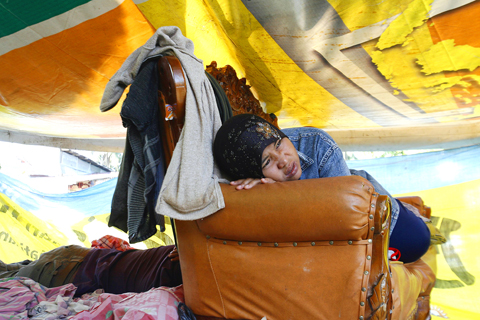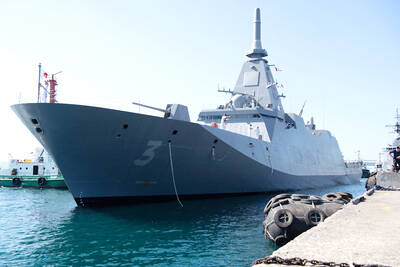With no outside help in sight, villagers used their bare hands yesterday to dig out rotting corpses, four days after landslides triggered by a huge earthquake obliterated four hamlets in western Indonesia.
Officials said at least 644 people were buried and presumed dead in the hillside villages in Padang Pariaman district on the western coast of Sumatra. If confirmed it would raise the death toll in Wednesday’s 7.6-magnitude earthquake to more than 1,300, with about 3,000 missing.
The extent of the disaster in remote villages was only now becoming clear. So far, aid and rescue efforts have been concentrated in the region’s capital, Padang, a city of 900,000 people where several tall buildings collapsed.

PHOTO: REUTERS
But the quake was equally devastating in the hills of Pariaman, where entire hillsides were shaken loose, sending a cascade of mud, rocks and trees through at least four villages.
Indonesian Vice President Jusuf Kalla said there was little hope of finding anyone alive.
“We can be sure that they are dead. So now we are waiting for burials,” he told reporters.
Where the villages once stood, there was only mud and broken palm trees — the mountainsides appeared gouged bare as if by a gigantic backhoe.
The villages “were sucked 30m deep into the earth,” said Rustam Pakaya, the head of Indonesia’s Health Ministry crisis center. “Even the mosque’s minaret, taller than 20m, disappeared.”
In Jumanak village, some 200 to 300 wedding guests at a restaurant were buried alive, including the bride and her 15-year-old brother, Iseh said.
He said his sister Ichi, 19, had come back to the village for her wedding.
“When the landslide came, the party had just finished. I heard a big boom of the avalanche. I ran outside and saw the trees fall down,” said Iseh, who like many Indonesians uses only one name.
“I tried to get in front of the house with my brothers. We were so afraid. Landslides started coming from all directions. I just ran and then I waited,” he said.
Iseh says he knows of only 10 people from the village who survived. He didn’t know the fate of his parents or brothers.
The adjacent villages of Pulau Aiya, Lubuk Lawe and Limo Koto Timur were also swept away.
Survivors in the area said no government aid or search teams had arrived, even four days after the quake. Only about 20 local policemen had come with a power shovel and body bags.
“My relatives were all killed, washed away by the landslide,” said Dola Jambak, a 48-year-old trader, picking through the rubble of his house. “I lost seven relatives. Now all I can do is wait for the search teams. But they don’t come.”
The landslides cut off all roads, and the villages were accessible only by foot.
Villagers gathered as men used their bare hands to slowly and cautiously pull corpses from a tangle of roots and grit. The bodies were bloated and mutilated, some unrecognizable. One man’s body was found because his hand was sticking out of the mud.
Women wept silently as bodies were placed in bright yellow bags.
Aid also had not reached Agam district, which is much closer to Padang.
Laila, a villager in Agam district, said she and hundreds of others had no food, clothes and clean water.
“Our house is gone ... everything is gone,” she sobbed.
In Padang, rescuers have all but given up hope of finding any survivors in the rubble of the 140-room, Dutch-colonial style Ambacang Hotel. Some 200 people were in the hotel when it collapsed.
Search teams have found 29 bodies so far, and no one alive.
“After four days .... to find survivors is almost impossible,” said Lieutenant Colonel Harris, the chief of the 50-member rescue team, which comprises military, police and Red Cross personnel.
“The smell of decomposing bodies is very strong,” said Harris, who uses one name.
The National Disaster Management Agency said 83,712 houses, 200 public buildings and 285 schools were destroyed. Another 100,000 buildings and 31km of road were badly damaged, and five bridges had collapsed.
Meanwhile, hundreds of doctors, nurses, search and rescue experts and cleanup crews arrived on Saturday at the Padang airport from around the world with tonnes of food, tents, medicine, clean water, generators and a field hospital.
But with no electricity, fuel shortages and telecommunication outages, the massive operation was chaotic.
Deliveries came on C-130 cargo planes from the US, Russia and Australia. Japanese, Swiss, South Korean and Malaysian search and rescue teams scoured the debris. Tens of millions of dollars in donations came from more than a dozen countries to supplement US$400 million the Indonesian government said it would spend over the next two months.
The UN said there are sufficient fuel stocks in the area for four days, but with the road to a major depot cut off by landslides, gasoline prices had jumped six-fold.
Areas with “huge levels of damage to infrastructure were in need of basic food and tents for temporary shelter,” it said.
Wednesday’s quake originated on the same fault line that spawned the 2004 Asian tsunami that killed 230,000 people in a dozen nations.
A 5.5-magnitude earthquake shook the eastern province of West Papua yesterday, the US Geological Survey said. There were no reports of casualties.

Eleven people, including a former minister, were arrested in Serbia on Friday over a train station disaster in which 16 people died. The concrete canopy of the newly renovated station in the northern city of Novi Sad collapsed on Nov. 1, 2024 in a disaster widely blamed on corruption and poor oversight. It sparked a wave of student-led protests and led to the resignation of then-Serbian prime minister Milos Vucevic and the fall of his government. The public prosecutor’s office in Novi Sad opened an investigation into the accident and deaths. In February, the public prosecutor’s office for organized crime opened another probe into

RISING RACISM: A Japanese group called on China to assure safety in the country, while the Chinese embassy in Tokyo urged action against a ‘surge in xenophobia’ A Japanese woman living in China was attacked and injured by a man in a subway station in Suzhou, China, Japanese media said, hours after two Chinese men were seriously injured in violence in Tokyo. The attacks on Thursday raised concern about xenophobic sentiment in China and Japan that have been blamed for assaults in both countries. It was the third attack involving Japanese living in China since last year. In the two previous cases in China, Chinese authorities have insisted they were isolated incidents. Japanese broadcaster NHK did not identify the woman injured in Suzhou by name, but, citing the Japanese

YELLOW SHIRTS: Many protesters were associated with pro-royalist groups that had previously supported the ouster of Paetongtarn’s father, Thaksin, in 2006 Protesters rallied on Saturday in the Thai capital to demand the resignation of court-suspended Thai Prime Minister Paetongtarn Shinawatra and in support of the armed forces following a violent border dispute with Cambodia that killed more than three dozen people and displaced more than 260,000. Gathered at Bangkok’s Victory Monument despite soaring temperatures, many sang patriotic songs and listened to speeches denouncing Paetongtarn and her father, former Thai prime minister Thaksin Shinawatra, and voiced their backing of the country’s army, which has always retained substantial power in the Southeast Asian country. Police said there were about 2,000 protesters by mid-afternoon, although

MOGAMI-CLASS FRIGATES: The deal is a ‘big step toward elevating national security cooperation with Australia, which is our special strategic partner,’ a Japanese official said Australia is to upgrade its navy with 11 Mogami-class frigates built by Japan’s Mitsubishi Heavy Industries, Australian Minister for Defence Richard Marles said yesterday. Billed as Japan’s biggest defense export deal since World War II, Australia is to pay US$6 billion over the next 10 years to acquire the fleet of stealth frigates. Australia is in the midst of a major military restructure, bolstering its navy with long-range firepower in an effort to deter China. It is striving to expand its fleet of major warships from 11 to 26 over the next decade. “This is clearly the biggest defense-industry agreement that has ever